NRSG366 Assessment Task 1 - Individual Case Study
VerifiedAdded on 2023/04/08
|6
|2230
|61
AI Summary
A case study on a 52-year-old male patient with uncontrolled diabetes and related health issues. Discusses the importance of proper diet, exercise, psychological interventions, and social support in managing the patient's health. Examines the link between obesity, type 2 diabetes, hypertension, sleep apnea, and GORD. Provides recommendations for therapy and care.
Contribute Materials
Your contribution can guide someone’s learning journey. Share your
documents today.
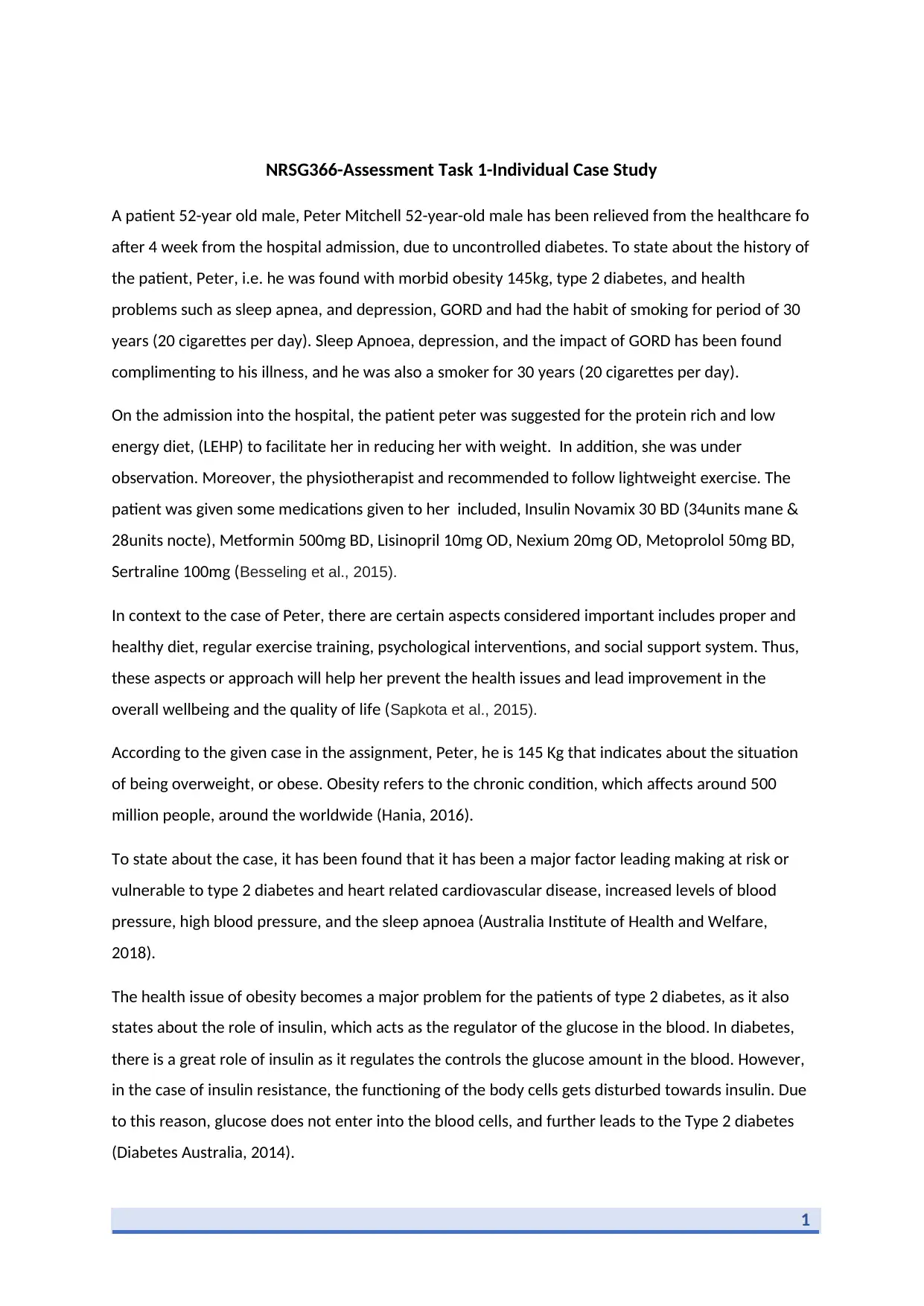
NRSG366-Assessment Task 1-Individual Case Study
A patient 52-year old male, Peter Mitchell 52-year-old male has been relieved from the healthcare fo
after 4 week from the hospital admission, due to uncontrolled diabetes. To state about the history of
the patient, Peter, i.e. he was found with morbid obesity 145kg, type 2 diabetes, and health
problems such as sleep apnea, and depression, GORD and had the habit of smoking for period of 30
years (20 cigarettes per day). Sleep Apnoea, depression, and the impact of GORD has been found
complimenting to his illness, and he was also a smoker for 30 years (20 cigarettes per day).
On the admission into the hospital, the patient peter was suggested for the protein rich and low
energy diet, (LEHP) to facilitate her in reducing her with weight. In addition, she was under
observation. Moreover, the physiotherapist and recommended to follow lightweight exercise. The
patient was given some medications given to her included, Insulin Novamix 30 BD (34units mane &
28units nocte), Metformin 500mg BD, Lisinopril 10mg OD, Nexium 20mg OD, Metoprolol 50mg BD,
Sertraline 100mg (Besseling et al., 2015).
In context to the case of Peter, there are certain aspects considered important includes proper and
healthy diet, regular exercise training, psychological interventions, and social support system. Thus,
these aspects or approach will help her prevent the health issues and lead improvement in the
overall wellbeing and the quality of life (Sapkota et al., 2015).
According to the given case in the assignment, Peter, he is 145 Kg that indicates about the situation
of being overweight, or obese. Obesity refers to the chronic condition, which affects around 500
million people, around the worldwide (Hania, 2016).
To state about the case, it has been found that it has been a major factor leading making at risk or
vulnerable to type 2 diabetes and heart related cardiovascular disease, increased levels of blood
pressure, high blood pressure, and the sleep apnoea (Australia Institute of Health and Welfare,
2018).
The health issue of obesity becomes a major problem for the patients of type 2 diabetes, as it also
states about the role of insulin, which acts as the regulator of the glucose in the blood. In diabetes,
there is a great role of insulin as it regulates the controls the glucose amount in the blood. However,
in the case of insulin resistance, the functioning of the body cells gets disturbed towards insulin. Due
to this reason, glucose does not enter into the blood cells, and further leads to the Type 2 diabetes
(Diabetes Australia, 2014).
1
A patient 52-year old male, Peter Mitchell 52-year-old male has been relieved from the healthcare fo
after 4 week from the hospital admission, due to uncontrolled diabetes. To state about the history of
the patient, Peter, i.e. he was found with morbid obesity 145kg, type 2 diabetes, and health
problems such as sleep apnea, and depression, GORD and had the habit of smoking for period of 30
years (20 cigarettes per day). Sleep Apnoea, depression, and the impact of GORD has been found
complimenting to his illness, and he was also a smoker for 30 years (20 cigarettes per day).
On the admission into the hospital, the patient peter was suggested for the protein rich and low
energy diet, (LEHP) to facilitate her in reducing her with weight. In addition, she was under
observation. Moreover, the physiotherapist and recommended to follow lightweight exercise. The
patient was given some medications given to her included, Insulin Novamix 30 BD (34units mane &
28units nocte), Metformin 500mg BD, Lisinopril 10mg OD, Nexium 20mg OD, Metoprolol 50mg BD,
Sertraline 100mg (Besseling et al., 2015).
In context to the case of Peter, there are certain aspects considered important includes proper and
healthy diet, regular exercise training, psychological interventions, and social support system. Thus,
these aspects or approach will help her prevent the health issues and lead improvement in the
overall wellbeing and the quality of life (Sapkota et al., 2015).
According to the given case in the assignment, Peter, he is 145 Kg that indicates about the situation
of being overweight, or obese. Obesity refers to the chronic condition, which affects around 500
million people, around the worldwide (Hania, 2016).
To state about the case, it has been found that it has been a major factor leading making at risk or
vulnerable to type 2 diabetes and heart related cardiovascular disease, increased levels of blood
pressure, high blood pressure, and the sleep apnoea (Australia Institute of Health and Welfare,
2018).
The health issue of obesity becomes a major problem for the patients of type 2 diabetes, as it also
states about the role of insulin, which acts as the regulator of the glucose in the blood. In diabetes,
there is a great role of insulin as it regulates the controls the glucose amount in the blood. However,
in the case of insulin resistance, the functioning of the body cells gets disturbed towards insulin. Due
to this reason, glucose does not enter into the blood cells, and further leads to the Type 2 diabetes
(Diabetes Australia, 2014).
1
Secure Best Marks with AI Grader
Need help grading? Try our AI Grader for instant feedback on your assignments.
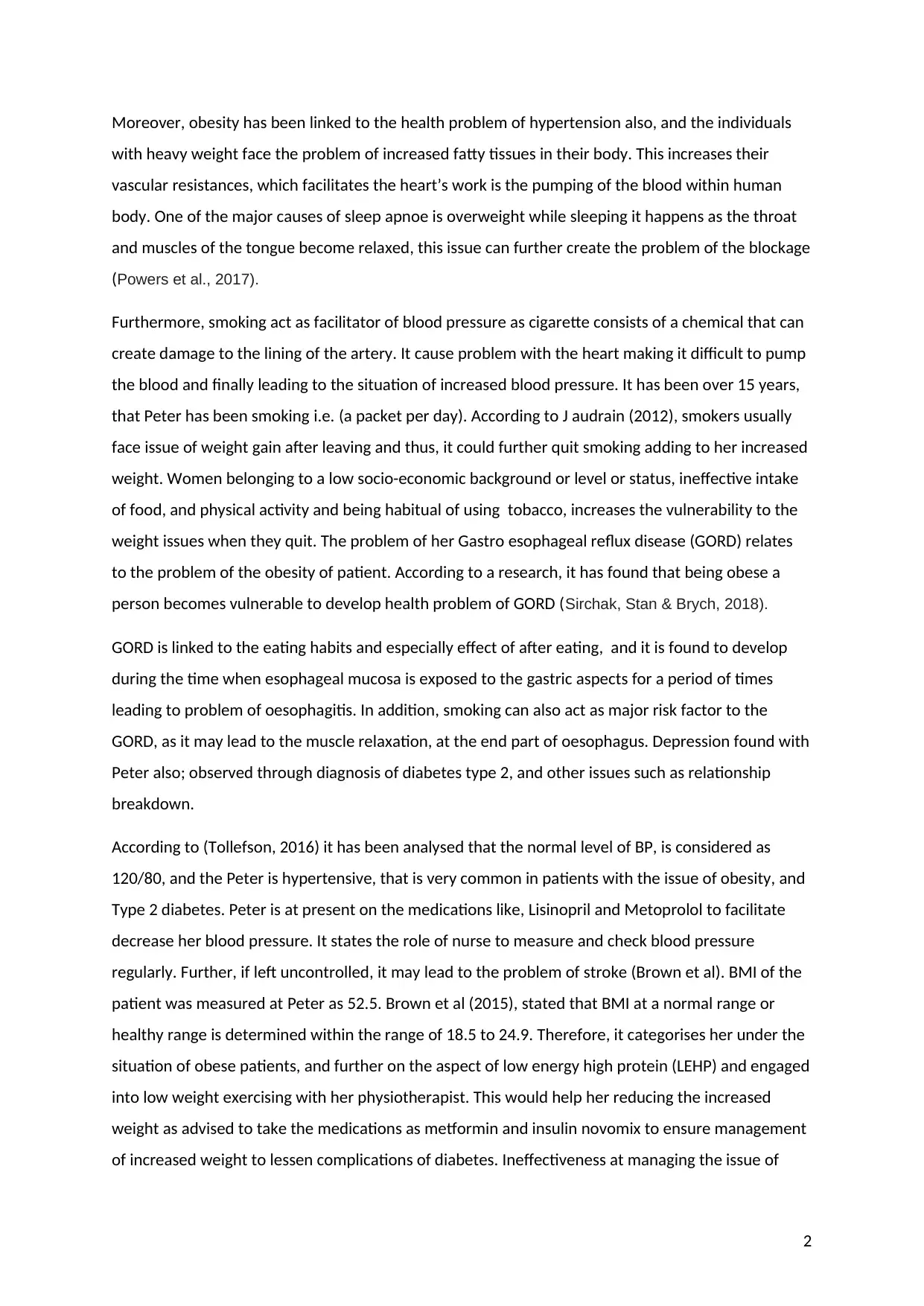
Moreover, obesity has been linked to the health problem of hypertension also, and the individuals
with heavy weight face the problem of increased fatty tissues in their body. This increases their
vascular resistances, which facilitates the heart’s work is the pumping of the blood within human
body. One of the major causes of sleep apnoe is overweight while sleeping it happens as the throat
and muscles of the tongue become relaxed, this issue can further create the problem of the blockage
(Powers et al., 2017).
Furthermore, smoking act as facilitator of blood pressure as cigarette consists of a chemical that can
create damage to the lining of the artery. It cause problem with the heart making it difficult to pump
the blood and finally leading to the situation of increased blood pressure. It has been over 15 years,
that Peter has been smoking i.e. (a packet per day). According to J audrain (2012), smokers usually
face issue of weight gain after leaving and thus, it could further quit smoking adding to her increased
weight. Women belonging to a low socio-economic background or level or status, ineffective intake
of food, and physical activity and being habitual of using tobacco, increases the vulnerability to the
weight issues when they quit. The problem of her Gastro esophageal reflux disease (GORD) relates
to the problem of the obesity of patient. According to a research, it has found that being obese a
person becomes vulnerable to develop health problem of GORD (Sirchak, Stan & Brych, 2018).
GORD is linked to the eating habits and especially effect of after eating, and it is found to develop
during the time when esophageal mucosa is exposed to the gastric aspects for a period of times
leading to problem of oesophagitis. In addition, smoking can also act as major risk factor to the
GORD, as it may lead to the muscle relaxation, at the end part of oesophagus. Depression found with
Peter also; observed through diagnosis of diabetes type 2, and other issues such as relationship
breakdown.
According to (Tollefson, 2016) it has been analysed that the normal level of BP, is considered as
120/80, and the Peter is hypertensive, that is very common in patients with the issue of obesity, and
Type 2 diabetes. Peter is at present on the medications like, Lisinopril and Metoprolol to facilitate
decrease her blood pressure. It states the role of nurse to measure and check blood pressure
regularly. Further, if left uncontrolled, it may lead to the problem of stroke (Brown et al). BMI of the
patient was measured at Peter as 52.5. Brown et al (2015), stated that BMI at a normal range or
healthy range is determined within the range of 18.5 to 24.9. Therefore, it categorises her under the
situation of obese patients, and further on the aspect of low energy high protein (LEHP) and engaged
into low weight exercising with her physiotherapist. This would help her reducing the increased
weight as advised to take the medications as metformin and insulin novomix to ensure management
of increased weight to lessen complications of diabetes. Ineffectiveness at managing the issue of
2
with heavy weight face the problem of increased fatty tissues in their body. This increases their
vascular resistances, which facilitates the heart’s work is the pumping of the blood within human
body. One of the major causes of sleep apnoe is overweight while sleeping it happens as the throat
and muscles of the tongue become relaxed, this issue can further create the problem of the blockage
(Powers et al., 2017).
Furthermore, smoking act as facilitator of blood pressure as cigarette consists of a chemical that can
create damage to the lining of the artery. It cause problem with the heart making it difficult to pump
the blood and finally leading to the situation of increased blood pressure. It has been over 15 years,
that Peter has been smoking i.e. (a packet per day). According to J audrain (2012), smokers usually
face issue of weight gain after leaving and thus, it could further quit smoking adding to her increased
weight. Women belonging to a low socio-economic background or level or status, ineffective intake
of food, and physical activity and being habitual of using tobacco, increases the vulnerability to the
weight issues when they quit. The problem of her Gastro esophageal reflux disease (GORD) relates
to the problem of the obesity of patient. According to a research, it has found that being obese a
person becomes vulnerable to develop health problem of GORD (Sirchak, Stan & Brych, 2018).
GORD is linked to the eating habits and especially effect of after eating, and it is found to develop
during the time when esophageal mucosa is exposed to the gastric aspects for a period of times
leading to problem of oesophagitis. In addition, smoking can also act as major risk factor to the
GORD, as it may lead to the muscle relaxation, at the end part of oesophagus. Depression found with
Peter also; observed through diagnosis of diabetes type 2, and other issues such as relationship
breakdown.
According to (Tollefson, 2016) it has been analysed that the normal level of BP, is considered as
120/80, and the Peter is hypertensive, that is very common in patients with the issue of obesity, and
Type 2 diabetes. Peter is at present on the medications like, Lisinopril and Metoprolol to facilitate
decrease her blood pressure. It states the role of nurse to measure and check blood pressure
regularly. Further, if left uncontrolled, it may lead to the problem of stroke (Brown et al). BMI of the
patient was measured at Peter as 52.5. Brown et al (2015), stated that BMI at a normal range or
healthy range is determined within the range of 18.5 to 24.9. Therefore, it categorises her under the
situation of obese patients, and further on the aspect of low energy high protein (LEHP) and engaged
into low weight exercising with her physiotherapist. This would help her reducing the increased
weight as advised to take the medications as metformin and insulin novomix to ensure management
of increased weight to lessen complications of diabetes. Ineffectiveness at managing the issue of
2
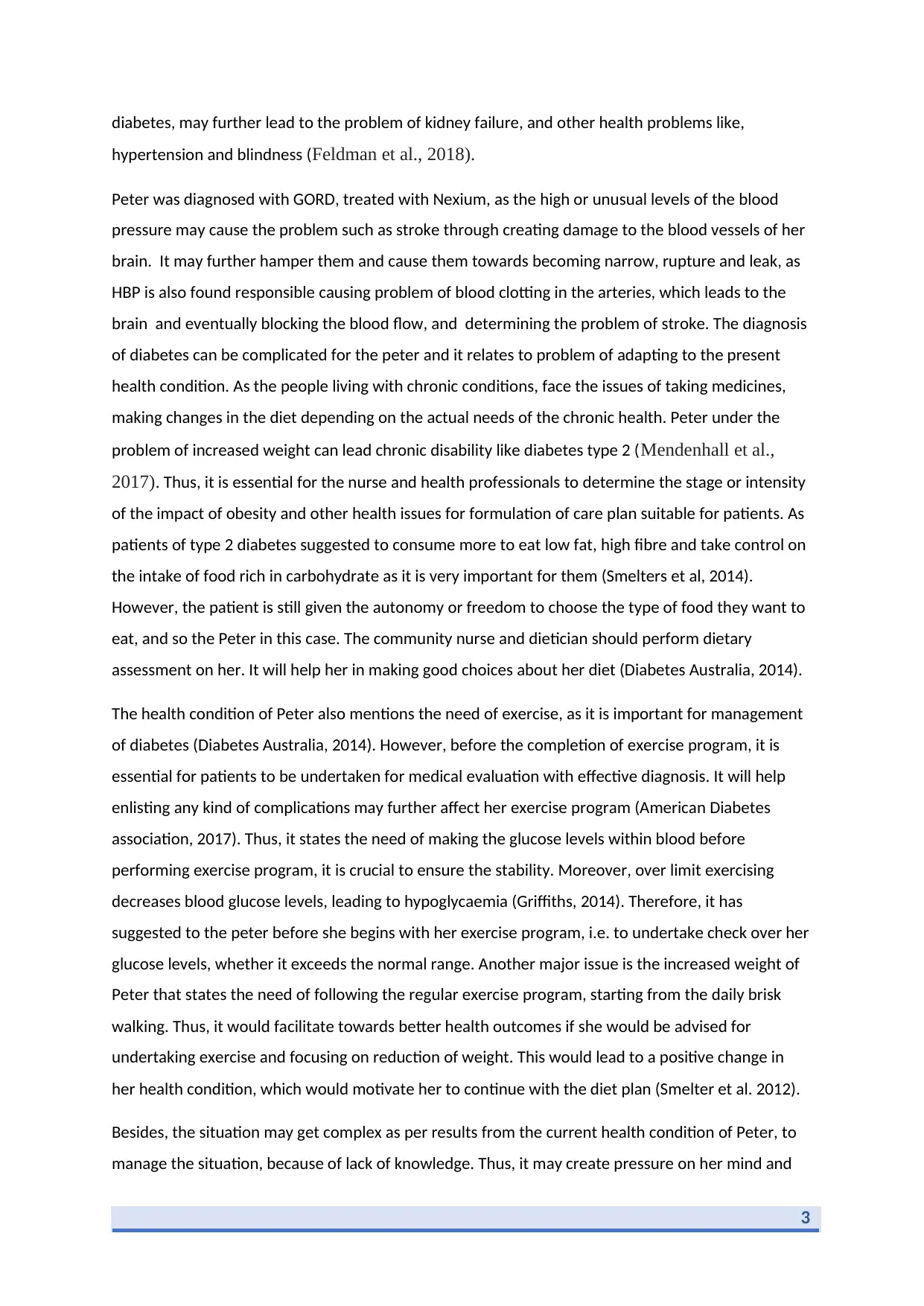
diabetes, may further lead to the problem of kidney failure, and other health problems like,
hypertension and blindness (Feldman et al., 2018).
Peter was diagnosed with GORD, treated with Nexium, as the high or unusual levels of the blood
pressure may cause the problem such as stroke through creating damage to the blood vessels of her
brain. It may further hamper them and cause them towards becoming narrow, rupture and leak, as
HBP is also found responsible causing problem of blood clotting in the arteries, which leads to the
brain and eventually blocking the blood flow, and determining the problem of stroke. The diagnosis
of diabetes can be complicated for the peter and it relates to problem of adapting to the present
health condition. As the people living with chronic conditions, face the issues of taking medicines,
making changes in the diet depending on the actual needs of the chronic health. Peter under the
problem of increased weight can lead chronic disability like diabetes type 2 (Mendenhall et al.,
2017). Thus, it is essential for the nurse and health professionals to determine the stage or intensity
of the impact of obesity and other health issues for formulation of care plan suitable for patients. As
patients of type 2 diabetes suggested to consume more to eat low fat, high fibre and take control on
the intake of food rich in carbohydrate as it is very important for them (Smelters et al, 2014).
However, the patient is still given the autonomy or freedom to choose the type of food they want to
eat, and so the Peter in this case. The community nurse and dietician should perform dietary
assessment on her. It will help her in making good choices about her diet (Diabetes Australia, 2014).
The health condition of Peter also mentions the need of exercise, as it is important for management
of diabetes (Diabetes Australia, 2014). However, before the completion of exercise program, it is
essential for patients to be undertaken for medical evaluation with effective diagnosis. It will help
enlisting any kind of complications may further affect her exercise program (American Diabetes
association, 2017). Thus, it states the need of making the glucose levels within blood before
performing exercise program, it is crucial to ensure the stability. Moreover, over limit exercising
decreases blood glucose levels, leading to hypoglycaemia (Griffiths, 2014). Therefore, it has
suggested to the peter before she begins with her exercise program, i.e. to undertake check over her
glucose levels, whether it exceeds the normal range. Another major issue is the increased weight of
Peter that states the need of following the regular exercise program, starting from the daily brisk
walking. Thus, it would facilitate towards better health outcomes if she would be advised for
undertaking exercise and focusing on reduction of weight. This would lead to a positive change in
her health condition, which would motivate her to continue with the diet plan (Smelter et al. 2012).
Besides, the situation may get complex as per results from the current health condition of Peter, to
manage the situation, because of lack of knowledge. Thus, it may create pressure on her mind and
3
hypertension and blindness (Feldman et al., 2018).
Peter was diagnosed with GORD, treated with Nexium, as the high or unusual levels of the blood
pressure may cause the problem such as stroke through creating damage to the blood vessels of her
brain. It may further hamper them and cause them towards becoming narrow, rupture and leak, as
HBP is also found responsible causing problem of blood clotting in the arteries, which leads to the
brain and eventually blocking the blood flow, and determining the problem of stroke. The diagnosis
of diabetes can be complicated for the peter and it relates to problem of adapting to the present
health condition. As the people living with chronic conditions, face the issues of taking medicines,
making changes in the diet depending on the actual needs of the chronic health. Peter under the
problem of increased weight can lead chronic disability like diabetes type 2 (Mendenhall et al.,
2017). Thus, it is essential for the nurse and health professionals to determine the stage or intensity
of the impact of obesity and other health issues for formulation of care plan suitable for patients. As
patients of type 2 diabetes suggested to consume more to eat low fat, high fibre and take control on
the intake of food rich in carbohydrate as it is very important for them (Smelters et al, 2014).
However, the patient is still given the autonomy or freedom to choose the type of food they want to
eat, and so the Peter in this case. The community nurse and dietician should perform dietary
assessment on her. It will help her in making good choices about her diet (Diabetes Australia, 2014).
The health condition of Peter also mentions the need of exercise, as it is important for management
of diabetes (Diabetes Australia, 2014). However, before the completion of exercise program, it is
essential for patients to be undertaken for medical evaluation with effective diagnosis. It will help
enlisting any kind of complications may further affect her exercise program (American Diabetes
association, 2017). Thus, it states the need of making the glucose levels within blood before
performing exercise program, it is crucial to ensure the stability. Moreover, over limit exercising
decreases blood glucose levels, leading to hypoglycaemia (Griffiths, 2014). Therefore, it has
suggested to the peter before she begins with her exercise program, i.e. to undertake check over her
glucose levels, whether it exceeds the normal range. Another major issue is the increased weight of
Peter that states the need of following the regular exercise program, starting from the daily brisk
walking. Thus, it would facilitate towards better health outcomes if she would be advised for
undertaking exercise and focusing on reduction of weight. This would lead to a positive change in
her health condition, which would motivate her to continue with the diet plan (Smelter et al. 2012).
Besides, the situation may get complex as per results from the current health condition of Peter, to
manage the situation, because of lack of knowledge. Thus, it may create pressure on her mind and
3
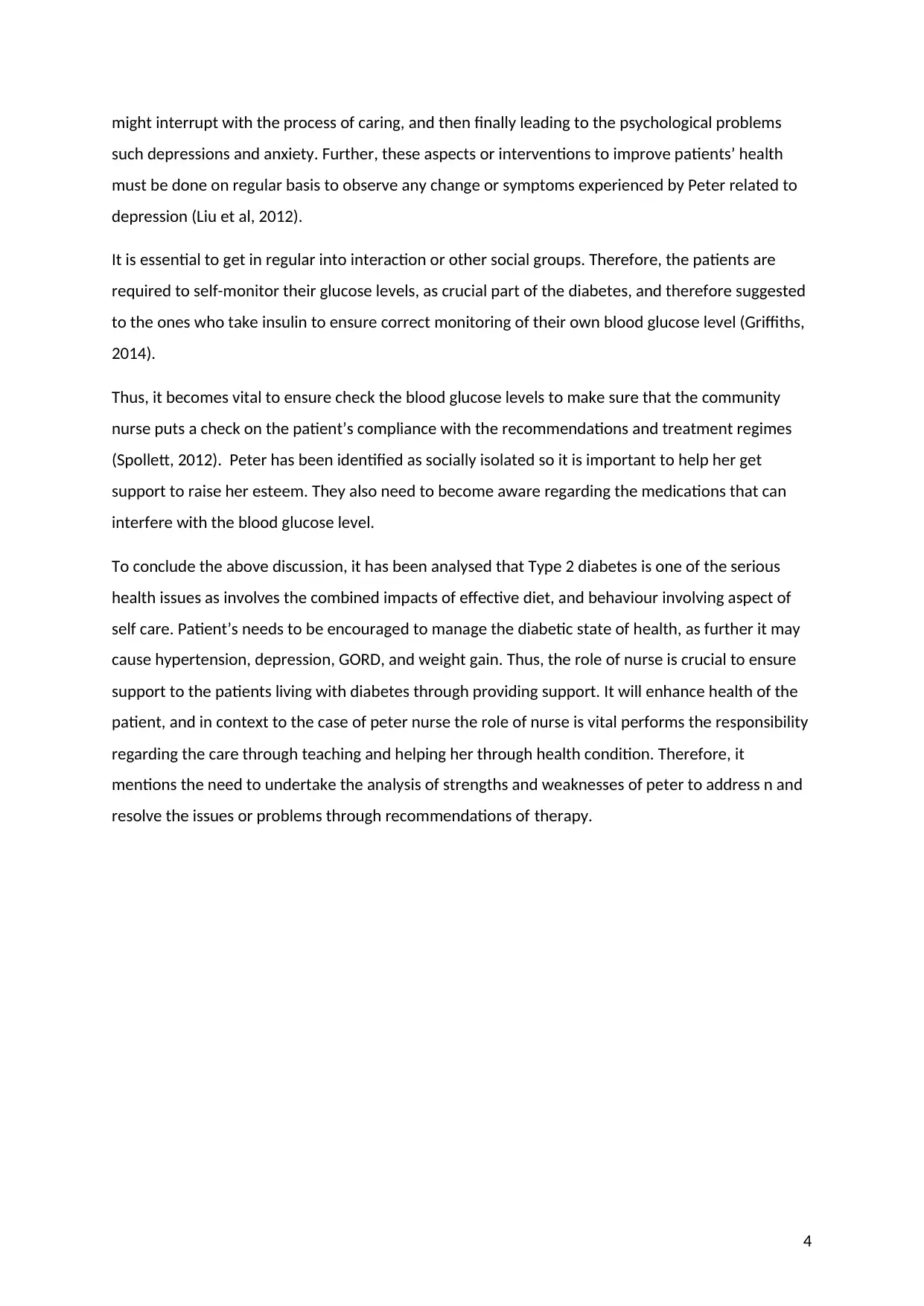
might interrupt with the process of caring, and then finally leading to the psychological problems
such depressions and anxiety. Further, these aspects or interventions to improve patients’ health
must be done on regular basis to observe any change or symptoms experienced by Peter related to
depression (Liu et al, 2012).
It is essential to get in regular into interaction or other social groups. Therefore, the patients are
required to self-monitor their glucose levels, as crucial part of the diabetes, and therefore suggested
to the ones who take insulin to ensure correct monitoring of their own blood glucose level (Griffiths,
2014).
Thus, it becomes vital to ensure check the blood glucose levels to make sure that the community
nurse puts a check on the patient’s compliance with the recommendations and treatment regimes
(Spollett, 2012). Peter has been identified as socially isolated so it is important to help her get
support to raise her esteem. They also need to become aware regarding the medications that can
interfere with the blood glucose level.
To conclude the above discussion, it has been analysed that Type 2 diabetes is one of the serious
health issues as involves the combined impacts of effective diet, and behaviour involving aspect of
self care. Patient’s needs to be encouraged to manage the diabetic state of health, as further it may
cause hypertension, depression, GORD, and weight gain. Thus, the role of nurse is crucial to ensure
support to the patients living with diabetes through providing support. It will enhance health of the
patient, and in context to the case of peter nurse the role of nurse is vital performs the responsibility
regarding the care through teaching and helping her through health condition. Therefore, it
mentions the need to undertake the analysis of strengths and weaknesses of peter to address n and
resolve the issues or problems through recommendations of therapy.
4
such depressions and anxiety. Further, these aspects or interventions to improve patients’ health
must be done on regular basis to observe any change or symptoms experienced by Peter related to
depression (Liu et al, 2012).
It is essential to get in regular into interaction or other social groups. Therefore, the patients are
required to self-monitor their glucose levels, as crucial part of the diabetes, and therefore suggested
to the ones who take insulin to ensure correct monitoring of their own blood glucose level (Griffiths,
2014).
Thus, it becomes vital to ensure check the blood glucose levels to make sure that the community
nurse puts a check on the patient’s compliance with the recommendations and treatment regimes
(Spollett, 2012). Peter has been identified as socially isolated so it is important to help her get
support to raise her esteem. They also need to become aware regarding the medications that can
interfere with the blood glucose level.
To conclude the above discussion, it has been analysed that Type 2 diabetes is one of the serious
health issues as involves the combined impacts of effective diet, and behaviour involving aspect of
self care. Patient’s needs to be encouraged to manage the diabetic state of health, as further it may
cause hypertension, depression, GORD, and weight gain. Thus, the role of nurse is crucial to ensure
support to the patients living with diabetes through providing support. It will enhance health of the
patient, and in context to the case of peter nurse the role of nurse is vital performs the responsibility
regarding the care through teaching and helping her through health condition. Therefore, it
mentions the need to undertake the analysis of strengths and weaknesses of peter to address n and
resolve the issues or problems through recommendations of therapy.
4
Secure Best Marks with AI Grader
Need help grading? Try our AI Grader for instant feedback on your assignments.
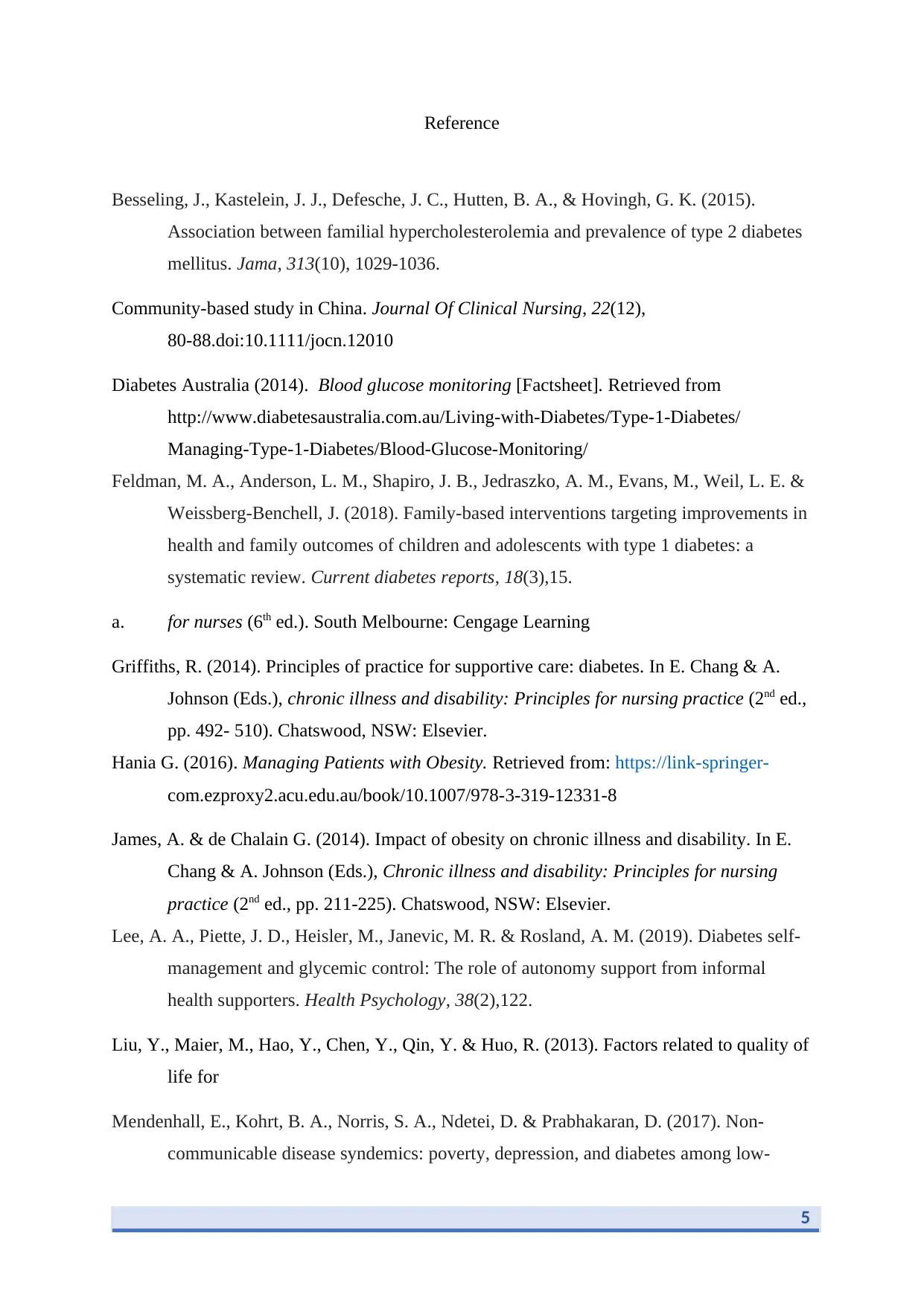
Reference
Besseling, J., Kastelein, J. J., Defesche, J. C., Hutten, B. A., & Hovingh, G. K. (2015).
Association between familial hypercholesterolemia and prevalence of type 2 diabetes
mellitus. Jama, 313(10), 1029-1036.
Community-based study in China. Journal Of Clinical Nursing, 22(12),
80-88.doi:10.1111/jocn.12010
Diabetes Australia (2014). Blood glucose monitoring [Factsheet]. Retrieved from
http://www.diabetesaustralia.com.au/Living-with-Diabetes/Type-1-Diabetes/
Managing-Type-1-Diabetes/Blood-Glucose-Monitoring/
Feldman, M. A., Anderson, L. M., Shapiro, J. B., Jedraszko, A. M., Evans, M., Weil, L. E. &
Weissberg-Benchell, J. (2018). Family-based interventions targeting improvements in
health and family outcomes of children and adolescents with type 1 diabetes: a
systematic review. Current diabetes reports, 18(3),15.
a. for nurses (6th ed.). South Melbourne: Cengage Learning
Griffiths, R. (2014). Principles of practice for supportive care: diabetes. In E. Chang & A.
Johnson (Eds.), chronic illness and disability: Principles for nursing practice (2nd ed.,
pp. 492- 510). Chatswood, NSW: Elsevier.
Hania G. (2016). Managing Patients with Obesity. Retrieved from: https://link-springer-
com.ezproxy2.acu.edu.au/book/10.1007/978-3-319-12331-8
James, A. & de Chalain G. (2014). Impact of obesity on chronic illness and disability. In E.
Chang & A. Johnson (Eds.), Chronic illness and disability: Principles for nursing
practice (2nd ed., pp. 211-225). Chatswood, NSW: Elsevier.
Lee, A. A., Piette, J. D., Heisler, M., Janevic, M. R. & Rosland, A. M. (2019). Diabetes self-
management and glycemic control: The role of autonomy support from informal
health supporters. Health Psychology, 38(2),122.
Liu, Y., Maier, M., Hao, Y., Chen, Y., Qin, Y. & Huo, R. (2013). Factors related to quality of
life for
Mendenhall, E., Kohrt, B. A., Norris, S. A., Ndetei, D. & Prabhakaran, D. (2017). Non-
communicable disease syndemics: poverty, depression, and diabetes among low-
5
Besseling, J., Kastelein, J. J., Defesche, J. C., Hutten, B. A., & Hovingh, G. K. (2015).
Association between familial hypercholesterolemia and prevalence of type 2 diabetes
mellitus. Jama, 313(10), 1029-1036.
Community-based study in China. Journal Of Clinical Nursing, 22(12),
80-88.doi:10.1111/jocn.12010
Diabetes Australia (2014). Blood glucose monitoring [Factsheet]. Retrieved from
http://www.diabetesaustralia.com.au/Living-with-Diabetes/Type-1-Diabetes/
Managing-Type-1-Diabetes/Blood-Glucose-Monitoring/
Feldman, M. A., Anderson, L. M., Shapiro, J. B., Jedraszko, A. M., Evans, M., Weil, L. E. &
Weissberg-Benchell, J. (2018). Family-based interventions targeting improvements in
health and family outcomes of children and adolescents with type 1 diabetes: a
systematic review. Current diabetes reports, 18(3),15.
a. for nurses (6th ed.). South Melbourne: Cengage Learning
Griffiths, R. (2014). Principles of practice for supportive care: diabetes. In E. Chang & A.
Johnson (Eds.), chronic illness and disability: Principles for nursing practice (2nd ed.,
pp. 492- 510). Chatswood, NSW: Elsevier.
Hania G. (2016). Managing Patients with Obesity. Retrieved from: https://link-springer-
com.ezproxy2.acu.edu.au/book/10.1007/978-3-319-12331-8
James, A. & de Chalain G. (2014). Impact of obesity on chronic illness and disability. In E.
Chang & A. Johnson (Eds.), Chronic illness and disability: Principles for nursing
practice (2nd ed., pp. 211-225). Chatswood, NSW: Elsevier.
Lee, A. A., Piette, J. D., Heisler, M., Janevic, M. R. & Rosland, A. M. (2019). Diabetes self-
management and glycemic control: The role of autonomy support from informal
health supporters. Health Psychology, 38(2),122.
Liu, Y., Maier, M., Hao, Y., Chen, Y., Qin, Y. & Huo, R. (2013). Factors related to quality of
life for
Mendenhall, E., Kohrt, B. A., Norris, S. A., Ndetei, D. & Prabhakaran, D. (2017). Non-
communicable disease syndemics: poverty, depression, and diabetes among low-
5
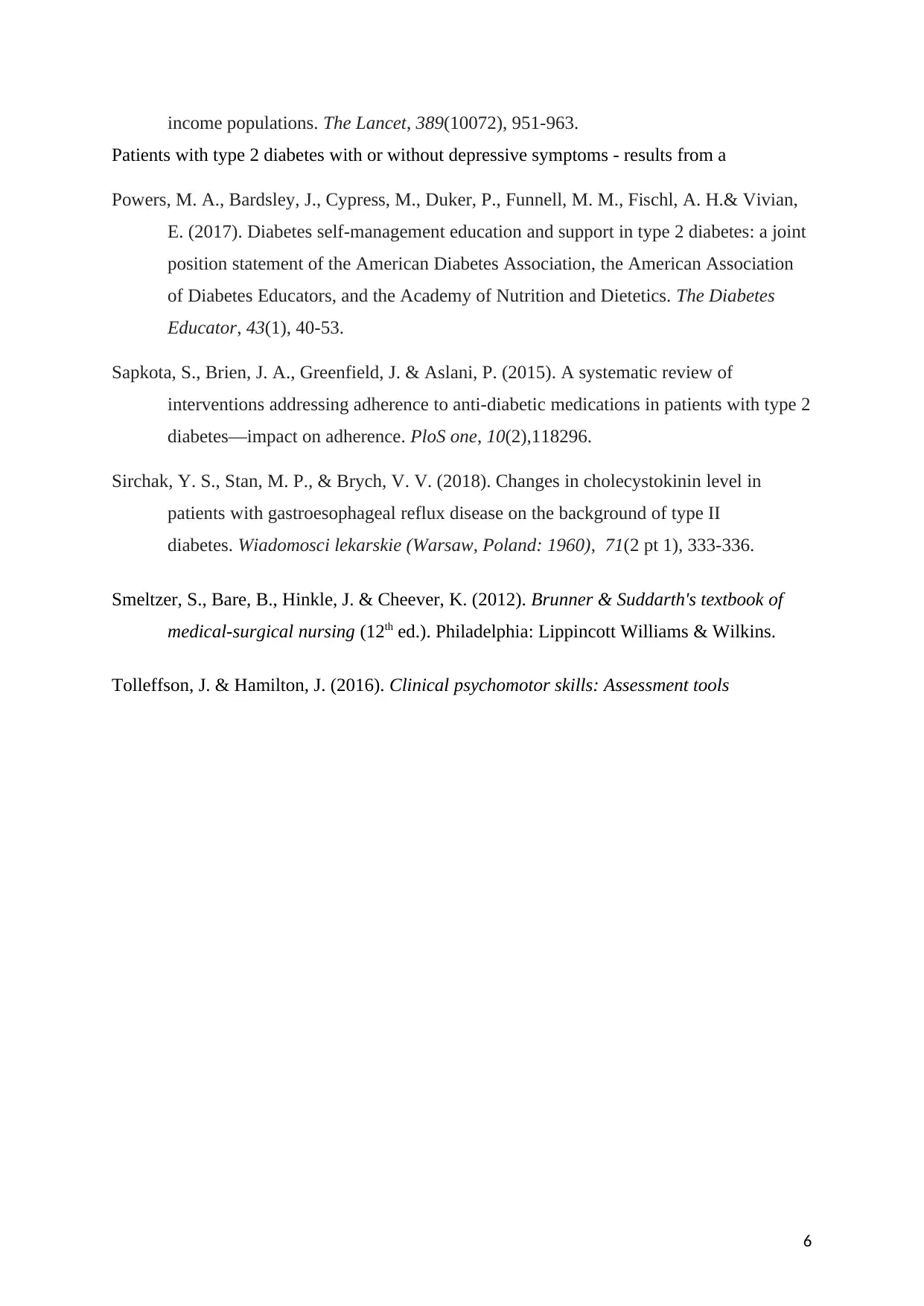
income populations. The Lancet, 389(10072), 951-963.
Patients with type 2 diabetes with or without depressive symptoms - results from a
Powers, M. A., Bardsley, J., Cypress, M., Duker, P., Funnell, M. M., Fischl, A. H.& Vivian,
E. (2017). Diabetes self-management education and support in type 2 diabetes: a joint
position statement of the American Diabetes Association, the American Association
of Diabetes Educators, and the Academy of Nutrition and Dietetics. The Diabetes
Educator, 43(1), 40-53.
Sapkota, S., Brien, J. A., Greenfield, J. & Aslani, P. (2015). A systematic review of
interventions addressing adherence to anti-diabetic medications in patients with type 2
diabetes—impact on adherence. PloS one, 10(2),118296.
Sirchak, Y. S., Stan, M. P., & Brych, V. V. (2018). Changes in cholecystokinin level in
patients with gastroesophageal reflux disease on the background of type II
diabetes. Wiadomosci lekarskie (Warsaw, Poland: 1960), 71(2 pt 1), 333-336.
Smeltzer, S., Bare, B., Hinkle, J. & Cheever, K. (2012). Brunner & Suddarth's textbook of
medical-surgical nursing (12th ed.). Philadelphia: Lippincott Williams & Wilkins.
Tolleffson, J. & Hamilton, J. (2016). Clinical psychomotor skills: Assessment tools
6
Patients with type 2 diabetes with or without depressive symptoms - results from a
Powers, M. A., Bardsley, J., Cypress, M., Duker, P., Funnell, M. M., Fischl, A. H.& Vivian,
E. (2017). Diabetes self-management education and support in type 2 diabetes: a joint
position statement of the American Diabetes Association, the American Association
of Diabetes Educators, and the Academy of Nutrition and Dietetics. The Diabetes
Educator, 43(1), 40-53.
Sapkota, S., Brien, J. A., Greenfield, J. & Aslani, P. (2015). A systematic review of
interventions addressing adherence to anti-diabetic medications in patients with type 2
diabetes—impact on adherence. PloS one, 10(2),118296.
Sirchak, Y. S., Stan, M. P., & Brych, V. V. (2018). Changes in cholecystokinin level in
patients with gastroesophageal reflux disease on the background of type II
diabetes. Wiadomosci lekarskie (Warsaw, Poland: 1960), 71(2 pt 1), 333-336.
Smeltzer, S., Bare, B., Hinkle, J. & Cheever, K. (2012). Brunner & Suddarth's textbook of
medical-surgical nursing (12th ed.). Philadelphia: Lippincott Williams & Wilkins.
Tolleffson, J. & Hamilton, J. (2016). Clinical psychomotor skills: Assessment tools
6
1 out of 6
Related Documents
Your All-in-One AI-Powered Toolkit for Academic Success.
+13062052269
info@desklib.com
Available 24*7 on WhatsApp / Email
![[object Object]](/_next/static/media/star-bottom.7253800d.svg)
Unlock your academic potential
© 2024 | Zucol Services PVT LTD | All rights reserved.





